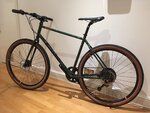ebikemom
Well-Known Member
In our four-ebike family, since we got our bikes, we have had, let's see ....
ALL of the flats have been REAR-wheel flats. Slime tubes. No patching possible.
So ... I'm thinking of various flat-avoidance strategies:
tire liners
Thanks for any advice!
- Son's bike: 1 flat
- Daughter's bike: 1 flat
- Husband's bike: 2 flats (one on his bike, one on a loaner)
- My bike: 0 flats (Lucky me!
)
ALL of the flats have been REAR-wheel flats. Slime tubes. No patching possible.
So ... I'm thinking of various flat-avoidance strategies:
tire liners
- thick/heavy-duty tubes
- tire liners
- tubeless tires
Thanks for any advice!

